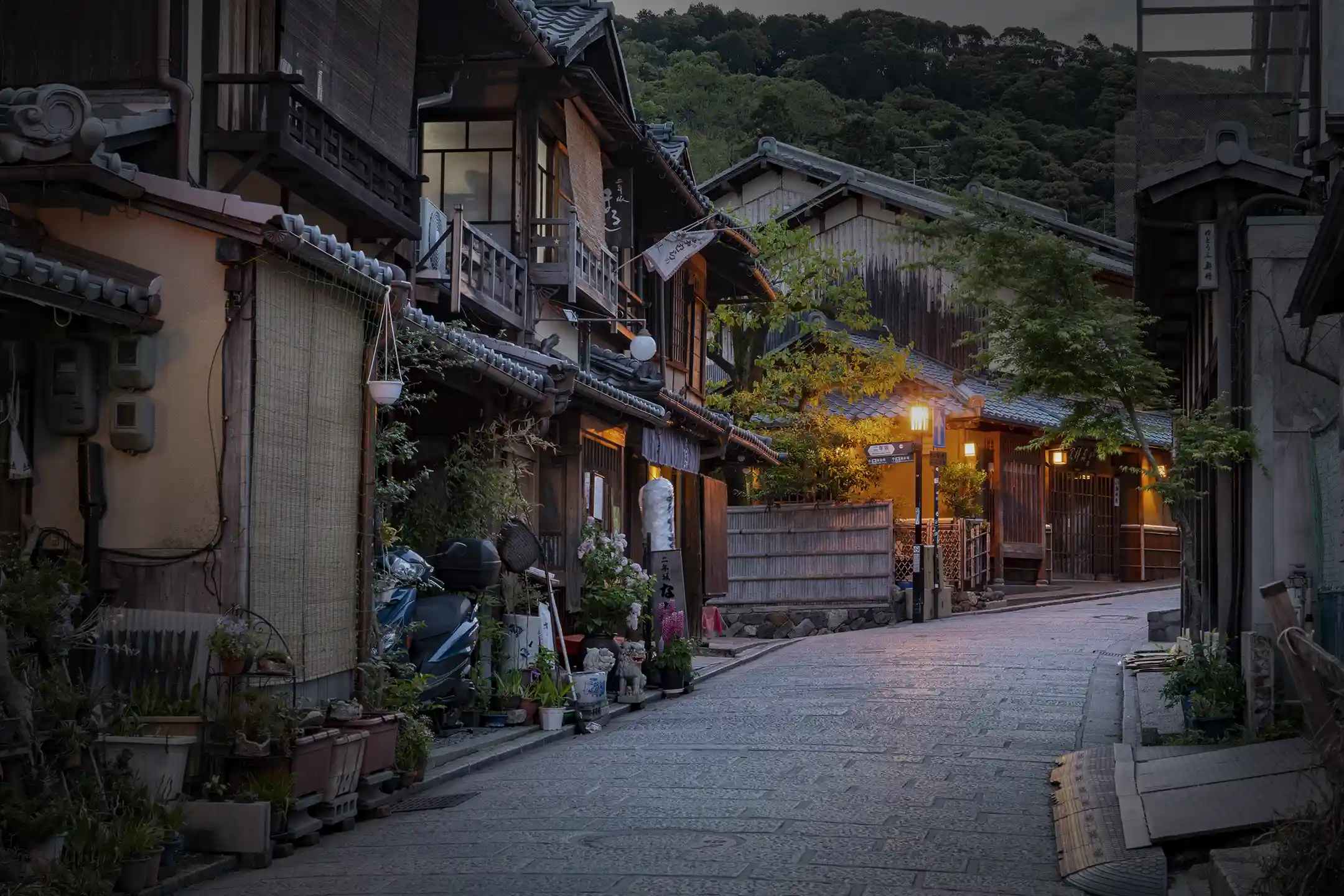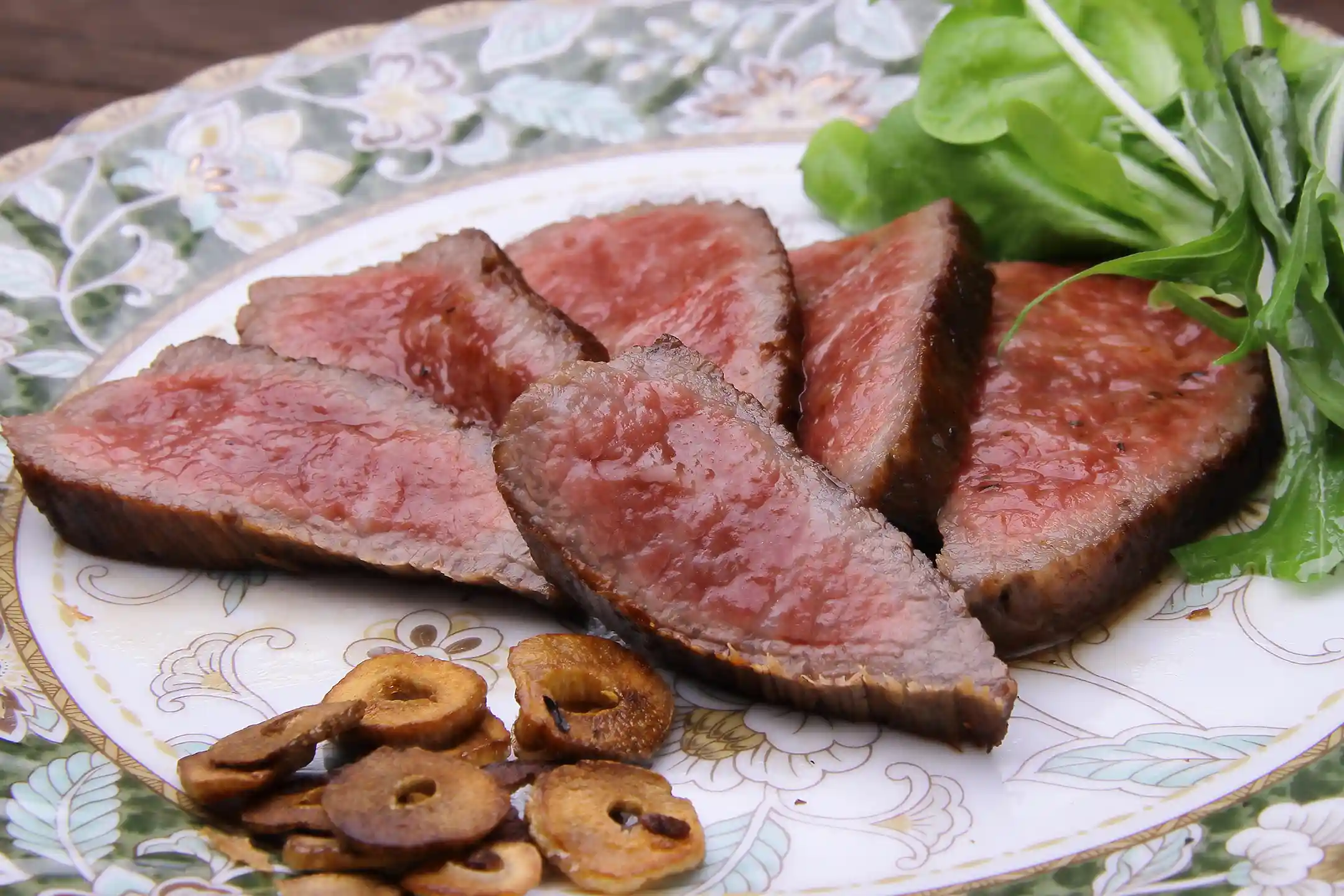Japan’s beauty lies in the stories woven through Japanese history and architecture. In Kyoto, Japan’s ancient capital, you can immerse yourself in the culture as you wander through Zen-inspired temple gardens and admire intricate Buddhist art. Here, the beauty of tranquility and emptiness (yohaku) evokes a quiet sense of awe within you — a feeling that’s strikingly different from the grandeur of Western cathedrals and paintings.
Meanwhile, in Ozu (Ehime Prefecture), you’ll encounter Ozu Castle — a historic fortress rebuilt in 2004 using traditional wooden construction techniques revived for the modern era. A journey encompassing both Kyoto and Ozu Castle provides a captivating introduction to Japan’s spiritual culture and architectural heritage, giving you the chance to deepen your understanding of a culture different from your own.
Kyoto Temple Visits—A Journey Through Historic Architecture and Culture
Kyoto boasts a rich history as Japan’s ancient capital, and this legacy is reflected profoundly in its temples and their unique spiritual traditions. These sacred structures offer a sense of tranquility and symbolism distinct from those of Western churches, providing fresh insights for visitors like you. Whether you’re strolling through a serene garden or admiring elaborate temple decorations, each experience helps you appreciate Japanese aesthetics and spiritual perspectives firsthand. Below, we’ll introduce a few representative temples showcasing Zen gardens and Buddhist artistic excellence, highlighting their unique features and attractions.
Experiencing Zen Architectural Aesthetics—Ryoan-ji’s Rock Garden and Ginkaku-ji’s Shoin-zukuri
Ryoan-ji Temple is famous for its karesansui (dry landscape) rock garden, where fifteen stones are artfully arranged on a bed of white gravel, such that no matter where you stand, one stone is always hidden from view — a subtle design that symbolizes Zen’s embrace of imperfection. (*1)
This minimalist representation of the universe — using nothing but rocks and empty space — epitomizes the wabi-sabi aesthetic, finding beauty in simplicity and impermanence rather than in the lush ornamentation of Western gardens.

Ginkaku-ji (formally known as Jishō-ji) was originally the retirement villa of Shogun Ashikaga Yoshimasa, and today it stands as a Zen temple that exudes understated elegance. Despite the nickname, it was never actually covered in silver — its unadorned form radiates a profound elegance. The two-story pavilion seamlessly blends Zen simplicity with aristocratic refinement, exemplifying the shoin-zukuri architectural style that later influenced Japanese residential architecture for generations. As you wander through Ginkaku-ji’s tranquil gardens, you’ll feel the deep allure of Zen philosophy intertwined with the refined Higashiyama culture of its era. (*2)

Treasures of Buddhist Art at Sanjusangendō—A Harmony of Faith and Art
Sanjusangendō Temple (named for its thirty-three intervals between pillars) houses 1,001 life-sized statues of Kannon, the Buddhist goddess of mercy. A seated Kannon at the center is surrounded by 1,000 standing ones, and each statue is regarded as a National Treasure or Important Cultural Property.

Stepping into the hall and seeing this sea of golden statues stretching out in rows can leave you speechless. Each figure has a unique expression and fine details, reflecting the deep spiritual devotion central to Japanese Buddhism. The hall itself was reconstructed in the Kamakura period (13th–14th century) and has stood for hundreds of years as a testament to extraordinary craftsmanship and longevity. Looking at these countless meticulously crafted statues, you truly sense how inseparable religion and art are in Japanese culture. (*3)
Expert-Guided Kyoto Temple Tours—Deepening Your Understanding of History, Architecture, and Buddhism
You can join specialized tours led by experts or Buddhist monks that offer deep insights into the history, architecture, and spiritual significance of the temples. These tours go beyond ordinary sightseeing — they invite you to gain a richer understanding of the culture of the temples. For visitors from abroad, this kind of in-depth experience is especially rewarding – it bridges cultural gaps and brings the stories of the temples to life.
Specialized Kyoto Tours on “Architecture and Buddhist Philosophy”
Imagine exploring a temple alongside an architectural historian or a Buddhist scholar. These expert-led tours reveal details and perspectives you won’t find in a standard guidebook. You might even gain special early morning access before the temple opens, guided by a monk who shares insights as you explore in peace. (*1)(*2)
Traditional Craft Experiences—Temple Architecture and Buddhist Craftsmanship Workshops
If you want to engage more directly with Japan’s traditions, join a hands-on craft workshop. Under the guidance of skilled artisans, you might carve a small wooden Buddha statue, apply gold leaf to a decorative object, or even practice classical wood joinery alongside master carpenters (miyadaiku) — gaining firsthand appreciation for the sustainable, long-lasting construction methods passed down through generations. (*3)(*4)

These activities are enjoyable, and they deepen your respect for the spiritual and aesthetic values that underpin Japan’s traditional craftsmanship and architectural heritage.
Must-See! 5 Historical Temples in Kyoto—Discover Architectural Beauty
Kyoto has countless temples, but we’ve picked five that stand out for their architectural and historical significance. Each offers unique highlights that allow you to appreciate different facets of Japan’s cultural heritage.
Kiyomizu-dera—Wooden Stage Born of Traditional Architectural Techniques
Kiyomizu-dera’s main hall is a marvel of traditional carpentry, built using the kake-zukuri (overhang) technique almost entirely without nails. Its famous wooden stage extends about 13 meters from the hillside, supported by 139 zelkova wood pillars. If you’re accustomed to Western architecture, it’s astonishing to see such a large structure built without a single nail.

This ingenious, flexible design isn’t just for show — it helps the structure absorb seismic shocks, a vital feature in earthquake-prone Japan. Stepping onto the stage, you’re rewarded with a panoramic view of Kyoto. Each season offers a different backdrop, and as you gaze out, you can feel the legacy of the artisans whose skill and devotion made this wonder possible. (*1)
Nanzen-ji—Exploring Garden Architecture from a Philosophical Perspective
Nanzen-ji, the highest-ranked of Kyoto’s Five Great Zen Temples, offers a fascinating blend of architectural styles. Within its peaceful grounds, you’ll find the famous dry landscape garden called “Tora-no-ko Watashi,” as well as an unexpected sight — a brick aqueduct known as “Suirokaku,” built in the late 19th century. This elegant arched aqueduct runs through the temple complex and looks like a piece of Europe, often coming as a surprise to visitors.
Seeing this piece of Western-style infrastructure harmoniously integrated into a traditional Zen temple is remarkable. It reflects Japan’s historical openness to foreign influences and its ability to adapt and blend different cultures. (*2)
Myōshin-ji—Appreciating Zen Architecture and Artistic Spaces
Myōshin-ji is a vast complex with over thirty sub-temples (tatchu) spread across its grounds. A slow, mindful walk through this Zen enclave allows you to savor a profound sense of peace, far from the rush of everyday life. Kanō Tan’yū’s “Cloud Dragon” painting adorns the ceiling of the Hatto (Lecture Hall). The dragon’s eyes seem to follow you wherever you go — an illusion that beautifully captures Zen ideas of perception and impermanence. You might even find yourself walking around the hall to see the dragon appear to come alive from different angles, a mesmerizing experience. (*3)
Tōfuku-ji—Spectacular Spot Where Garden and Architecture Intertwine
Tōfuku-ji Temple is famed for the thousands of maple trees on its grounds that blaze with color each autumn, yet it offers a harmony between architecture and nature year-round. Founded in the 13th century, Tōfuku-ji is home to Japan’s oldest Zen-style Sanmon gate, designated a National Treasure. Walking beneath this massive gate, you can’t help but feel a sense of reverence.
Inside, you’ll find the “Hassō-no-Niwa” garden, a modern masterpiece designed by landscape architect Shigemori Mirei. This striking checkerboard garden design fuses modern creativity with traditional Zen aesthetics, showing how Japanese design traditions can adapt across eras. (*4)
Kinkaku-ji—A Symbol of Lavish Zen Architecture
Kinkaku-ji (officially Rokuon-ji) is one of Japan’s most iconic sights — a pavilion covered entirely in gold leaf that gleams in the sunlight. While it’s undeniably photogenic, a closer look reveals more to this temple than its glittering exterior.

Each of Kinkaku-ji’s three levels showcases a different architectural style — aristocratic, samurai, and Zen — illustrating the diverse aesthetic sensibilities of its era. As you stroll around the Mirror Lake, you enjoy a landscape garden that offers something new in every season. (*5)
Strolling Kyoto’s Historic Streets—Enjoy Traditional Architecture with All Five Senses
Between temple visits, take time to wander Kyoto’s historic streets. In areas with stone-paved alleys and traditional wooden machiya townhouses, you can appreciate the architecture along with the sounds of daily life and the tempting aromas of local cuisine.
Beyond the famous sights listed in guidebooks, the real charm of Kyoto often lies in its quiet backstreets. Here, you’ll encounter authentic local culture — a delightful experience that engages all five senses and can become a highlight of your trip.
Gion—Where Traditional Beauty and Contemporary Culture Coexist
Gion is Kyoto’s most famous geisha district, and it remains a vibrant hub of traditional culture. As you walk down the stone-paved Hanami-kōji lane, you’ll pass refined teahouses and exclusive restaurants where geisha and maiko perform. If you’re lucky, you might glimpse a maiko in her exquisite kimono at dusk. If so, remember to remain respectful and refrain from taking any photos.
Gion isn’t stuck in the past — it’s a living neighborhood where old traditions and modern trends mingle gracefully. Many of its wooden machiya houses now host stylish cafes, boutiques, and art galleries. This blend of historic elegance and contemporary creativity makes Gion’s atmosphere unique. Strolling through these streets shows that Kyoto’s traditions are still alive. (*1)
Philosopher’s Path—A Historic Stroll Infused with Literature and Art
The Philosopher’s Path is a scenic canal-side trail that runs from near Ginkaku-ji to Nanzen-ji. It’s famous for cherry blossoms in spring and colorful maple leaves in autumn, and it’s named after philosopher Nishida Kitarō, who loved walking here for contemplation. Along the way, you’ll find small galleries, craft shops, and charming cafes that add a local artistic touch to the scenery.
More than just a pretty walk, the Philosopher’s Path encourages quiet reflection. As you follow the trail at a leisurely pace, you can soak in the peaceful atmosphere and let your mind wander. No matter the season, this path gently reminds you that change is constant and each moment has its own beauty. (*2)

Conclusion
A journey through Kyoto’s temples and Ozu Castle offers you a unique opportunity to connect with the essence of Japanese culture by experiencing its history and architecture firsthand. In Zen places like Ryōan-ji and Ginkaku-ji, you discover how profound beauty can emerge from simplicity, while standing in Sanjusangendō Hall amid a thousand Kannon statues shows how deeply faith and art intertwine in Japan’s spiritual heritage.
Standing on Kiyomizu-dera’s wooden stage or gazing at Kinkaku-ji’s golden reflection, you see that the craftsmanship of past generations is still alive today. At Ozu Castle, you witness history reborn. Its reconstruction using traditional techniques in the modern era testifies to Japan’s spirit of honoring the past while embracing the future. In the surrounding town, age-old traditions persist even as new ideas take root.
Throughout the journey, you’ll witness historic architecture seamlessly integrated with everyday local life — scenes that will resonate with you even if you come from a different culture. In the end, experiencing Japan’s timeless traditions alongside its forward-looking spirit makes this journey deeply enriching. You’ll return home not only with memories but also with a deeper understanding of Japan’s history, architecture, and culture.
Author Bio





.webp)
.webp)